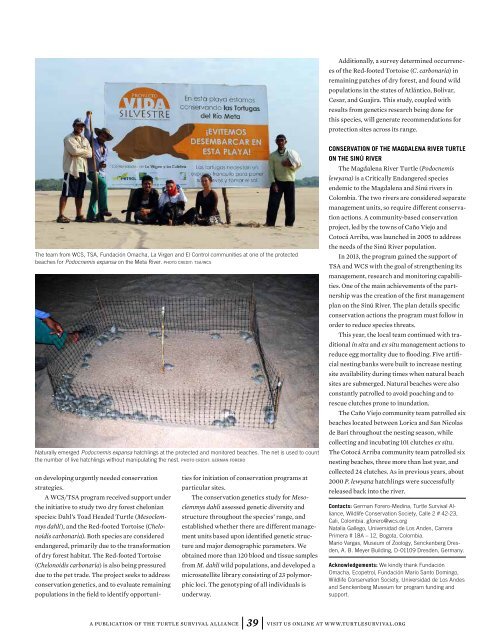Turtle Survival
2tUaeTbNi
2tUaeTbNi
You also want an ePaper? Increase the reach of your titles
YUMPU automatically turns print PDFs into web optimized ePapers that Google loves.
Additionally, a survey determined occurrences<br />
of the Red-footed Tortoise (C. carbonaria) in<br />
remaining patches of dry forest, and found wild<br />
populations in the states of Atlántico, Bolívar,<br />
Cesar, and Guajira. This study, coupled with<br />
results from genetics research being done for<br />
this species, will generate recommendations for<br />
protection sites across its range.<br />
The team from WCS, TSA, Fundación Omacha, La Virgen and El Control communities at one of the protected<br />
beaches for Podocnemis expansa on the Meta River. PHOTO CREDIT: TSA/WCS<br />
Naturally emerged Podocnemis expansa hatchlings at the protected and monitored beaches. The net is used to count<br />
the number of live hatchlings without manipulating the nest. PHOTO CREDIT: GERMAN FORERO<br />
on developing urgently needed conservation<br />
strategies.<br />
A WCS/TSA program received support under<br />
the initiative to study two dry forest chelonian<br />
species: Dahl’s Toad Headed <strong>Turtle</strong> (Mesoclemmys<br />
dahli), and the Red-footed Tortoise (Chelonoidis<br />
carbonaria). Both species are considered<br />
endangered, primarily due to the transformation<br />
of dry forest habitat. The Red-footed Tortoise<br />
(Chelonoidis carbonaria) is also being pressured<br />
due to the pet trade. The project seeks to address<br />
conservation genetics, and to evaluate remaining<br />
populations in the field to identify opportuni-<br />
ties for initiation of conservation programs at<br />
particular sites.<br />
The conservation genetics study for Mesoclemmys<br />
dahli assessed genetic diversity and<br />
structure throughout the species’ range, and<br />
established whether there are different management<br />
units based upon identified genetic structure<br />
and major demographic parameters. We<br />
obtained more than 120 blood and tissue samples<br />
from M. dahli wild populations, and developed a<br />
microsatellite library consisting of 23 polymorphic<br />
loci. The genotyping of all individuals is<br />
underway.<br />
CONSERVATION OF THE MAGDALENA RIVER TURTLE<br />
ON THE SINÚ RIVER<br />
The Magdalena River <strong>Turtle</strong> (Podocnemis<br />
lewyana) is a Critically Endangered species<br />
endemic to the Magdalena and Sinú rivers in<br />
Colombia. The two rivers are considered separate<br />
management units, so require different conservation<br />
actions. A community-based conservation<br />
project, led by the towns of Caño Viejo and<br />
Cotocá Arriba, was launched in 2005 to address<br />
the needs of the Sinú River population.<br />
In 2013, the program gained the support of<br />
TSA and WCS with the goal of strengthening its<br />
management, research and monitoring capabilities.<br />
One of the main achievements of the partnership<br />
was the creation of the first management<br />
plan on the Sinú River. The plan details specific<br />
conservation actions the program must follow in<br />
order to reduce species threats.<br />
This year, the local team continued with traditional<br />
in situ and ex situ management actions to<br />
reduce egg mortality due to flooding. Five artificial<br />
nesting banks were built to increase nesting<br />
site availability during times when natural beach<br />
sites are submerged. Natural beaches were also<br />
constantly patrolled to avoid poaching and to<br />
rescue clutches prone to inundation.<br />
The Caño Viejo community team patrolled six<br />
beaches located between Lorica and San Nicolas<br />
de Bari throughout the nesting season, while<br />
collecting and incubating 101 clutches ex situ.<br />
The Cotocá Arriba community team patrolled six<br />
nesting beaches, three more than last year, and<br />
collected 24 clutches. As in previous years, about<br />
2000 P. lewyana hatchlings were successfully<br />
released back into the river.<br />
Contacts: German Forero-Medina, <strong>Turtle</strong> <strong>Survival</strong> Alliance,<br />
Wildlife Conservation Society, Calle 2 # 42-23,<br />
Cali, Colombia. gforero@wcs.org<br />
Natalia Gallego, Universidad de Los Andes, Carrera<br />
Primera # 18A – 12, Bogota, Colombia.<br />
Mario Vargas, Museum of Zoology, Senckenberg Dresden,<br />
A. B. Meyer Building, D-01109 Dresden, Germany.<br />
Acknowledgements: We kindly thank Fundación<br />
Omacha, Ecopetrol, Fundación Mario Santo Domingo,<br />
Wildlife Conservation Society, Universidad de Los Andes<br />
and Senckenberg Museum for program funding and<br />
support.<br />
a publication of the turtle survival alliance 39 visit us online at www.turtlesurvival.org


